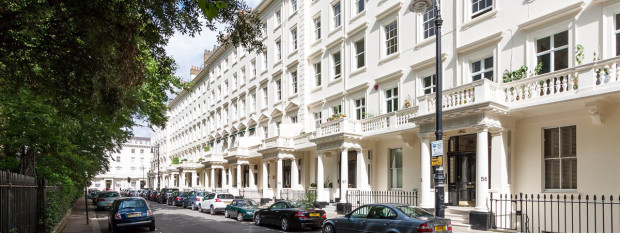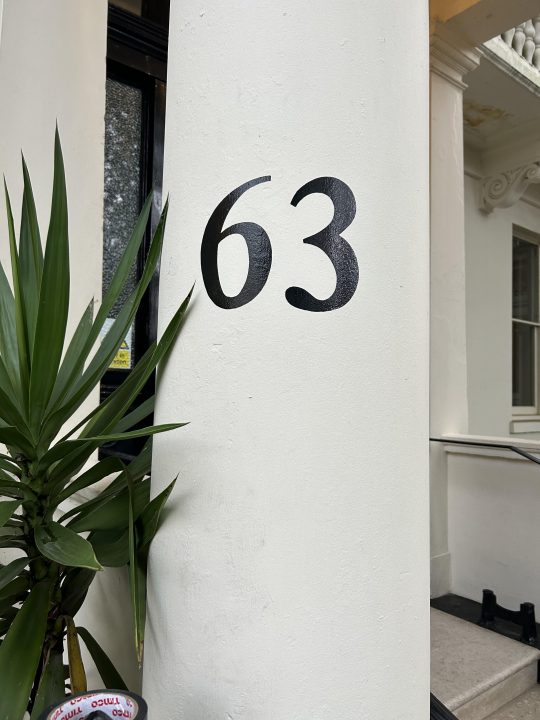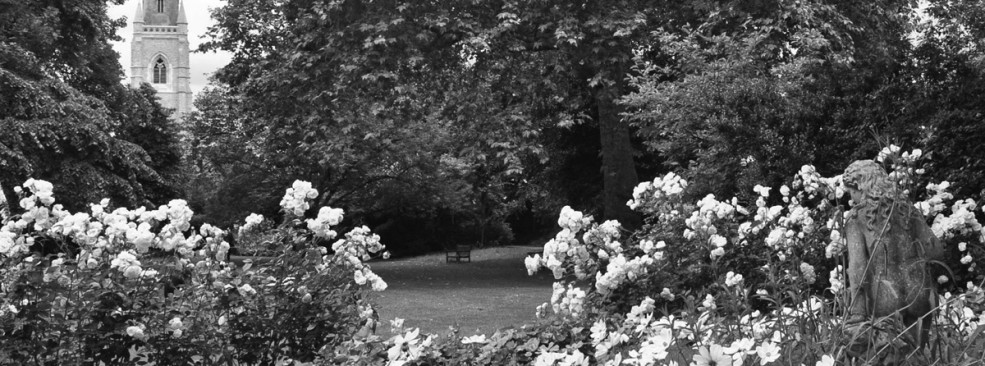Click on the green headings below to read the full story:
Magnificent Magnolia

The houses of Warwick Square present a splendid vista of cream-painted stucco, especially when viewed through the trees from within our award-winning garden. This pattern of finely dressed, evenly coloured house fronts became fashionable in large areas of central London during the late 18th century and continues to be the motif of the Thomas Cubitt terraces and squares of Belgravia and Pimlico.
In Warwick Square the various blocks of houses tend to be repainted on the outside every seven years or so and it is important that a standard colour is used to maintain the glorious uniformity. For the information of block directors, and all residents, this colour is Magnolia BS08B15. The recommended masonry paint is Daccrete 59 WB Gloss Finish. https://dacrylate.co.uk/products/product-range/daccrete-59wb/.
This information is supplied to us by an experienced chartered surveyor who has acted as project manager for many external redecoration projects in London conservation areas.
One issue that is far from standard, however, is the type face used for house numbers. Some numbers have been criticised as being more suited to a railway station. In recent years, however, some blocks have repainted their numerals in Times New Roman (see illustration). Warwick Square would be even more splendid if all our portico numbers were rendered in this elegant type face. Black, of course.
If any freeholding company is looking to select an external redecoration manager, the Warwick Square Company can provide the contact details for a chartered surveyor company experienced with buildings in Warwick Square: please contact Colin Sheaf: colin.sheaf@outlook.com.

David Bowie was a Square kinda guy
Did you know that David Bowie once rocked up in Warwick Square? Well, you probably wouldn’t unless you had lived here in the 1960s and even then you might not have glimpsed him nipping in and out of Number 79A. That’s where Bowie was sharing a flat with music promotor Kenny Bell. Only he wasn’t David Bowie just yet: his real name was prosaic David Jones.
When Jones revealed that he wanted to change his name to Bowie, Kenny said: “That’s a stupid name. Fancy naming yourself after a knife” (the one made famous at the battle of the Alamo).
Bell was Bowie’s business partner as well as his flat mate and had funded him to record demo tapes, but it was years before Bowie became a superstar famous throughout the world – and beyond. All is revealed in the Times obituary of Kenny, who died recently at the age of 89, click here.
Warwick Square, Pimlico and St Gabriel’s Church
Blood on the pavement: colourful stories of Warwick Square
Brian Eastman tells the fascinating story of the ups and downs of running the affairs of Warwick Square for many years. Such as the bloody day residents fought on the pavement over a dispute, the “as new” carpet that had to be thrown away because it had rotted away years ago, and the tangled legal feuds that led to many headaches, and large bills…. read more
Homage to the garden in Warwick Square
by Sandor P Vaci RIBArt.
An architect’s artistic tribute to Warwick Square garden.
Now that I have completed some fifty sketches of the Garden and its flora it is only fitting that I write an introduction of what brought it on and some thoughts on the connection between the actual and the perceived.
Drawing is part our training of becoming architects, the essential means of conveying designs to our clients which once approved are turned into technical information for construction. Even now, when everything is done on computers, the challenge of seeing or imagining the vision onto paper remains… read more
Pimlico, London – rare 1950s film of Thomas Cubitt’s stucco streets
Some priceless views of Pimlico in London, made during the 1950s. Many of the buildings and streets in these films have been demolished or redeveloped. However, there are many streets and buildings still very recognisable today.
These pieces of originally silent film appear to have been either outtakes, film made for atmosphere or just as a recce of the area. They were made for two 1950s British feature films made in the 1950s. Most of the clips are connected to the film “Hunted” which starred Dirk Bogarde, and was released in 1952. Some are connected with the later film “Innocent Sinners” starring Flora Robson and David Kossoff, and released in 1958… read more
How Warwick Square survived the Blitz

Book cover
Two fascinating wartime maps of Warwick Square and Pimlico have been sent in by our Head Gardener Sarah Syborn – discovered by her husband Philip in a book about bomb damage.
The map of Warwick Square shows that, amazingly, we suffered not a scratch in the Blitz, though nearby streets such as Moreton Place had it very rough. The colour code indicates the degree of damage, with black and blue representing complete destruction…. read more
The carpenter who helped to build Pimlico. A fascinating history
A book review by Peter Hill, a Warwick Square resident
History seldom tells us about ordinary people and it was fascinating to read the autobiography of William Symons Julian, a Cornish farm boy who learned a carpenter’s trade and came to London in the 1860s and helped to build Pimlico. William’s memoir was discovered in an attic by his descendants… read more
It’s all in the detail – interesting architectural features in Warwick Square and Pimilico
by Jan Michelet, a Warwick Square resident
Photos and explanations by Warwick Square resident Jan Michelet showing some of the interesting architectural details that you may have not noticed in and around Warwick Square… read more
Join ‘The Thorney Island Society’!
www.thethorneyislandsociety.org.uk
Interested in local Westminster history and the built environment, ranging from prehistoric wetlands until the 20th century? Concerned about the challenges our historic neighbour faces today from ill-considered local development? Please join ‘The Thorney Island Society’… read more
My quest for a key to the secret garden
by Anon., resident of Warwick Square Mews
I was warned that London is very parochial and where you start you are likely to end up. Never were truer words spoken to a young man seeking to make a career here. Business and finance beckoned and Pimlico was the chosen neighbourhood for me. It was cheap and clean but most of all central. A ten -minute walk from Sloane Square and a stone’s throw from Victoria. A dalliance in Dolphin Square, the purchase of a ground floor flat in St George’s Drive followed by a bijou house in Warwick Square Mews… > read more
A history of the local area
by Peter Hill, resident of Warwick Square
Pimlico was a swampy osier bed with a scattering of cottages until increasing demand for property made the unfashionable West London start to look attractive… > read more
Memories of the Square
by Steve McManus, resident from the 1950s to 1983
My family and I moved to Warwick Square in the late 1950s. I vividly remember being made lookout for the arrival of the Bishop & Sons removal van that was on its way to number fourteen via Buckingham Palace Road, the unofficial border between the elegant environs of Belgravia and the still evident bombsites of Pimlico… > read more
The Saving of Warwick Square
by Tony Hudson (1932–2015)
When we bought our flat here in 1983, moving from a house in Sussex Street when I took up an overseas posting, the freehold of the 224 residences which eventually comprised Warwick Square Co Ltd had since 1979 been owned by an Arab property company, Behbehani Buildings. These residences are not all those with a Warwick Square address, but only those on the north and south sides of the square plus a few in St. George’s Drive… > read more
Pimlico SW1: maps of the local area
by Ken Sparkes, resident of Warwick Square
Ever since Lord Grosvenor did the deal with Thomas Cubitt in 1825, Pimlico has tended to be more about aspiration than inspiration. One struggles to find extraordinary points of interest to boast about. We have no Grand Houses, Victorian serial killers, ancient monuments or tourist attractions to offer you. There are no white-cubed art galleries, hipster hangouts, designer boutiques or billionaire ghettos… > read more

